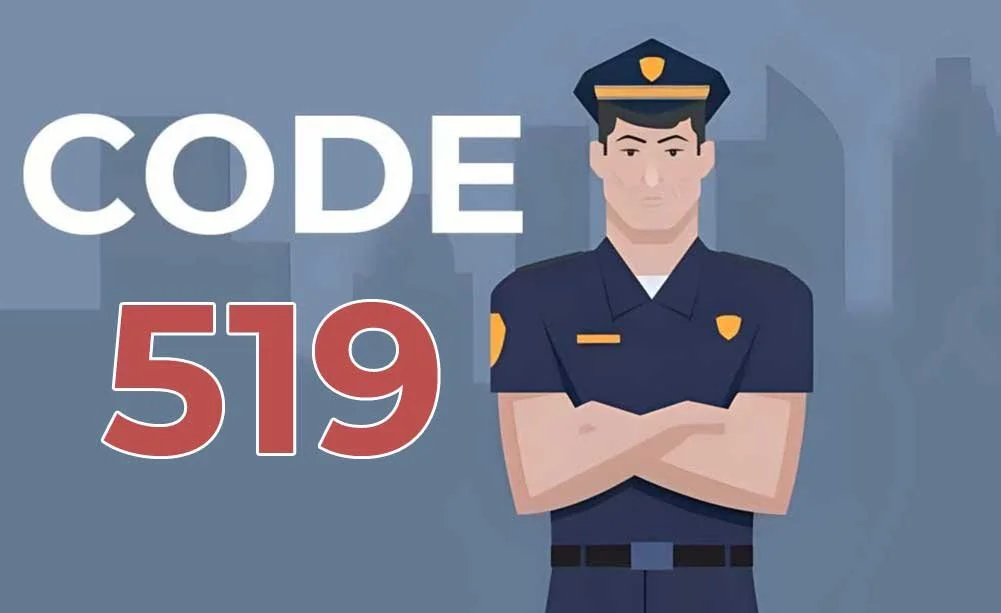What Is A 519 Police Code?
The world of police codes is a complex one, often filled with cryptic numbers and abbreviations that are hard to decipher for the uninitiated.
One such code that has gained some attention and curiosity is the 519 police code. In this blog post, we'll delve into the meaning behind this specific code, its origin, and its usage in various law enforcement agencies.
We'll also explore the broader context of police codes and how they contribute to effective communication within the field. So, buckle up as we unravel the mystery behind the 519 police code.
Question: What is a 519 police code?
Answer: Police code 519 can be used to alert officers to cases involving:
illegal use of property
trespassing
vandalism
Related Questions
-
No, police codes can vary by jurisdiction and region, including between different countries.
Some codes may be widely recognized across multiple regions or countries, but it is important to understand that police codes can vary depending on local laws, customs, and language differences.
-
Law enforcement agencies use codes as a shorthand way of communicating with each other and keeping sensitive information private.
Codes allow officers to communicate quickly and efficiently without revealing important information to anyone who may be listening on a scanner or radio.
What is a 519 Police Code?
Before diving into the meaning of the 519 police code, it's essential to understand that police codes, also known as "ten codes" or "signal codes," vary depending on the jurisdiction and the specific law enforcement agency using them.
That being said, the 519 police code generally refers to "illegal use of property" or "trespassing."
In some jurisdictions, it can also indicate "vandalism" or "malicious mischief."
These codes serve as a shorthand method of communication among law enforcement personnel, allowing them to relay information quickly and efficiently without the need for lengthy explanations.
The 519 police code, in particular, alerts officers to a situation involving unauthorized access, damage, or the illegal use of someone else's property.
It's crucial for officers to respond to such calls promptly to protect property owners' rights and ensure public safety.
Origin of Police Codes
Police codes, including the 519 police code, have their roots in the early days of law enforcement when officers relied on radio communication to exchange information.
The introduction of two-way radio systems in the 1930s revolutionized the way police officers communicated with each other and their dispatch centers.
However, this newfound connectivity also exposed the need for a standardized system to convey messages succinctly and efficiently.
To address this issue, the Association of Public-Safety Communications Officials (APCO) developed the first set of standardized police codes, known as "ten codes," in the 1940s.
These codes used the number "10" as a prefix, followed by another number to indicate specific situations or actions.
The purpose of these codes was to streamline communication, minimize radio chatter, and overcome the limitations of early radio systems, which often suffered from poor signal quality and interference.
Over time, various law enforcement agencies across the United States adopted these ten codes, modifying and expanding them to suit their specific needs.
As a result, police codes, including the 519 code, can have slightly different meanings depending on the jurisdiction.
Understanding the 519 Code in Context
To better comprehend the 519 police code's application, let's examine it in the context of illegal use of property, trespassing, and vandalism.
Illegal Use of Property: The 519 code can alert officers to situations where individuals are using someone else's property without permission.
This could include squatting in vacant buildings, occupying land without the owner's consent, or utilizing a property for unlawful activities, such as drug manufacturing or running an illegal gambling operation.
Trespassing: Trespassing refers to entering or remaining on someone else's property without their permission, and it's one of the most common scenarios associated with the 519 police code.
Trespassing can range from minor offenses, such as entering a restricted area or cutting through someone's yard, to more severe cases, like breaking and entering or home invasion.
Vandalism and Malicious Mischief: In some jurisdictions, the 519 police code may also signify vandalism or malicious mischief.
Vandalism encompasses various acts of property damage, such as graffiti, smashing windows, or damaging vehicles.
Malicious mischief involves intentionally causing damage or destruction to another person's property out of ill will or spite.
Importance of Accurate Communication
Now that we've unraveled the meaning behind the 519 police code, it's essential to understand the critical role that accurate communication plays in law enforcement.
Effective communication allows officers to respond swiftly and appropriately to various incidents, ensuring public safety and preventing misunderstandings that can lead to potentially dangerous situations.
Using standardized police codes, like the 519 code, is one-way law enforcement agencies achieve clear and efficient communication.
These codes enable officers to share information about incidents, suspects, and their own status quickly, reducing the time it takes to relay vital information. This streamlined communication can be crucial in emergencies or fast-paced situations where every second counts.
However, the use of police codes is not without its challenges.
As previously mentioned, the meanings of specific codes can vary depending on the jurisdiction, which can lead to confusion when officers from different agencies collaborate or when individuals move between jurisdictions.
Furthermore, some codes have become outdated or fallen out of use, leading to occasional misunderstandings among officers.
To address these issues, many law enforcement agencies have transitioned to using plain language or "clear speech" in radio communications.
This approach minimizes confusion and ensures that everyone involved, including dispatchers, officers, and other first responders, understands the message being conveyed.
While police codes like the 519 code continue to be used in some jurisdictions, the trend towards plain language communication is growing.
Conclusion
The 519 police code, which typically refers to illegal use of property, trespassing, or vandalism, is just one example of the many codes used by law enforcement agencies to communicate effectively and efficiently.
While these codes have served a crucial purpose in streamlining communication and improving response times, they are not without their challenges.
As law enforcement agencies continue to evolve and adapt to new technologies and communication methods, the future of police codes, including the 519 code, remains uncertain.
However, the need for clear and accurate communication in the field will always be a top priority, whether it involves using traditional codes or transitioning to plain language communication.
In the meantime, understanding codes like the 519 police code can provide valuable insight into the world of law enforcement and the challenges officers face daily.
By demystifying these codes, we can foster a greater appreciation for the work police officers do and the complexities of their profession.












Inside the Investigation: A Deeper Dive into Police Detective Benefits